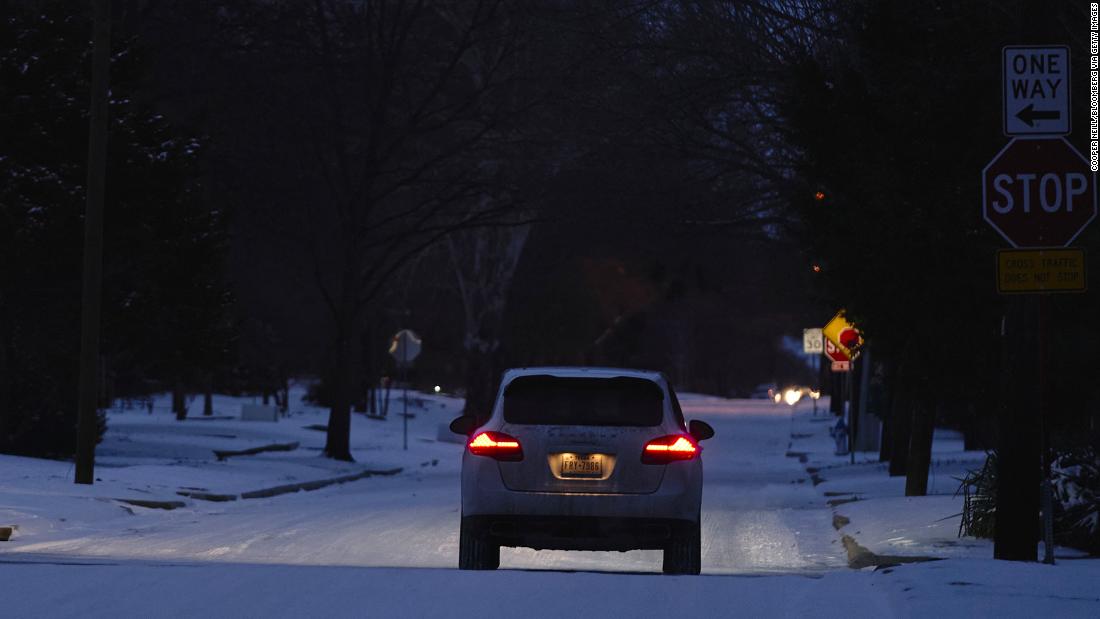Millions without electricity, water or food in Texas 3:46
(CNN) -
Winter storms ravaged long stretches of the United States this week, creating dangerous conditions on roads from Texas to New York.
Bad weather has led to at least 37 deaths, including several deaths as a result of car accidents, across the country, as one winter weather system followed another in the past six days.
As states continue to dig through the slippery mess, officials warned people to avoid driving unless absolutely necessary and to use extreme caution if driving.
This is because snow, sleet, and freezing rain covered cars, frozen roads, and hampered the visibility of millions of drivers.
But many motorists, especially those in the southern United States, may not be familiar with driving through sleet or black ice.
Here is a short guide to driving safely in winter weather:
Pack a gear for winter driving
If motorists have any problems with their car's battery, brakes, heating and cooling system, or ignition system, they should try to stay off the roads.
advertising
For those who must go out, planning is important.
The American Automobile Association (AAA) recommends that motorists wear winter driving gear that includes:
- A bag of abrasive material (sand, salt or kitty litter), a snow shovel and traction mats
- An ice scraper and glass cleaner
- Start cables
- A flashlight and warning flares or triangles
- A cell phone and charger
- An extra pair of gloves and a blanket
- Emergency food supplies like protein bars or beef jerky.
And water.
Motorists should also have at least a half tank of fuel before heading out, AAA says, and make sure their tires are properly inflated.
Always defrost your vehicle before driving
Vehicles with ice can limit the driver's visibility, and ice coming off cars can be dangerous to other drivers, so defrost vehicles before driving.
The AAA suggests that drivers clean their windows and windshields, replace their wiper blades if they leave marks, and clean all snow and ice from their hood, roof, trunk, lights and windows.
Drivers should warm up their car's engine for a few minutes before hitting the road.
READ
: Nearly half of Texans must boil their water as shortages and freezing temperatures continue
Drive slowly, with your headlights on, and avoid stopping frequently
When driving in poor visibility conditions, drivers should move slowly with low beams on, advises AAA.
The AAA also recommends that drivers avoid stopping if possible.
Instead, motorists must drive slowly to keep their car rolling without needing to come to a complete stop.
Avoiding an obstruction is often safer than sudden braking at speeds greater than 40 km / h on a slippery surface, according to the AAA booklet, "How to Go on Ice and Snow."
When motorists brake, they should not take their foot off the brake or pump the pedal if they have antilock brakes, advises AAA.
Drivers who do not have antilock brakes should keep their heel on the ground and apply firm pressure to the brake pedal to the lock threshold.
In the event of a skid, drivers are advised to steer in the direction they want the front of the car to go, keeping their eyes on the driving path.
They should not brake hard as it is likely to be more difficult to regain control.
Additionally, the AAA suggests that drivers avoid autopilot when driving on slippery ice, sleet or snow surfaces.
Exit the parking lots carefully
Drivers should try to get their vehicle out of parking spaces without spinning the wheels.
Drive back and forth for several feet in any direction to clear a path, AAA advises, and sprinkle sand or salt near the wheels if additional traction is needed.
LEE
: More than 60 million in the US under winter weather alerts as rain and snow hit the east coast
Keep as much distance as possible with other vehicles
To safely brake if necessary, AAA advises drivers to increase following distances to 8 to 10 seconds when driving on ice or snow.
On highways, drivers should not change lanes frequently, as they can lose control when driving on snow that accumulates between the lanes.
Drive through the hills as slowly as possible
When driving on hills, drivers should stay as far away from other vehicles as possible so they don't have to stop while maneuvering around stuck cars.
This will allow drivers to accelerate smoothly when near the bottom of the hill, AAA says.
Motorists should drive downhill on ice or snow very slowly and try not to use the brakes.
However, when necessary, drivers should brake smoothly to avoid losing control.
CNN's Marnie Hunter, Jason Hanna, Madeline Holcombe, and Steve Almasy contributed to this report.
winter storm







